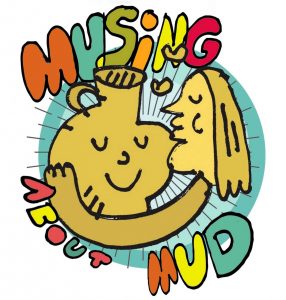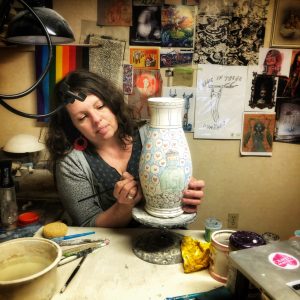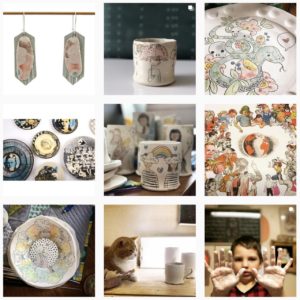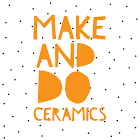Deadline:
COB Friday 22 August 2014
COB Friday 22 August 2014
About
Stepping Up, the 2015 Australian Ceramics Triennale, is the premier event that
brings our ceramics community together. To be held in the national capital,
Canberra, an exciting and diverse program will showcase ceramics through a
series of important discourses and conversations, masterclasses and
exhibitions.
Stepping Up, the 2015 Australian Ceramics Triennale, is the premier event that
brings our ceramics community together. To be held in the national capital,
Canberra, an exciting and diverse program will showcase ceramics through a
series of important discourses and conversations, masterclasses and
exhibitions.
Dates
Public programs commence Monday 6 July 2015
Public programs commence Monday 6 July 2015
Conference
Program Thursday 9 – Saturday 11 July 2015
Program Thursday 9 – Saturday 11 July 2015
General
Guidelines for Speakers
Guidelines for Speakers
•
Speakers will deliver a presentation for ten minutes, followed by a moderated Q
and A session with conference delegates.
Speakers will deliver a presentation for ten minutes, followed by a moderated Q
and A session with conference delegates.
•
A final abstract must be prepared by each speaker and submitted to the session
chair by 1 November 2014 for inclusion on the website (300 words)
A final abstract must be prepared by each speaker and submitted to the session
chair by 1 November 2014 for inclusion on the website (300 words)
•
A completed final paper must be submitted for the printed program by 1 March
2015 Themes 1.
A completed final paper must be submitted for the printed program by 1 March
2015 Themes 1.
Stepping
Up- the Changing World Around 500BCE Heraclitus said “The only thing that is
constant is change”. Despite intermittent periods of relative stability, change
continues to be a central characteristic of life, particularly in the late 20th
and early 21st centuries. As a group of people who work with or are associated
with one of the world’s oldest art materials, how do we adapt to or, indeed,
drive change? Ceramics courses in universities (and those TAFEs that are still
running them) are being cut to save money, whilst community pottery groups are
booming, and international residency opportunities and mentorships are
increasing. So what will ceramics training and education look like in the
future? From the rapid prototyping of old (throwing on the potters’ wheel), 3-D
printing is being explored in ceramics – it is fast becoming commonplace in
other materials. What are the implications of this for studio pottery and
ceramic design? Will the seductive power of ‘new’ technology spell the end of
studio practice as we have known it, or will clay – the material of our current
creation – prove resistant to uptake? Laser and waterjet cutting have found
their niches in craft practice (including ceramics), as have many other
industrial processes; so is there a studio of the future that will engage with
all of this? By 2020, over one third of the world’s population will live in
China and India, and when the whole of Asia is counted, projections have more
than 50% of the world’s population living in this region. Australia is well
placed to be active in securing a seat on this express train, but what are we
doing about it now? How will this affect our practices, our output, our
livelihood and our understanding of ‘our’ culture?
Up- the Changing World Around 500BCE Heraclitus said “The only thing that is
constant is change”. Despite intermittent periods of relative stability, change
continues to be a central characteristic of life, particularly in the late 20th
and early 21st centuries. As a group of people who work with or are associated
with one of the world’s oldest art materials, how do we adapt to or, indeed,
drive change? Ceramics courses in universities (and those TAFEs that are still
running them) are being cut to save money, whilst community pottery groups are
booming, and international residency opportunities and mentorships are
increasing. So what will ceramics training and education look like in the
future? From the rapid prototyping of old (throwing on the potters’ wheel), 3-D
printing is being explored in ceramics – it is fast becoming commonplace in
other materials. What are the implications of this for studio pottery and
ceramic design? Will the seductive power of ‘new’ technology spell the end of
studio practice as we have known it, or will clay – the material of our current
creation – prove resistant to uptake? Laser and waterjet cutting have found
their niches in craft practice (including ceramics), as have many other
industrial processes; so is there a studio of the future that will engage with
all of this? By 2020, over one third of the world’s population will live in
China and India, and when the whole of Asia is counted, projections have more
than 50% of the world’s population living in this region. Australia is well
placed to be active in securing a seat on this express train, but what are we
doing about it now? How will this affect our practices, our output, our
livelihood and our understanding of ‘our’ culture?
Conversation
1- New technologies
1- New technologies
Conversation
2- Asian Century
2- Asian Century
Conversation
3- Education
3- Education
2.
Stepping Up- Your Role in the future Although there persists a romantic view of
the potter or ceramic artist working alone or in a small team – either in a
rural or urban setting, how closely does this reflect the truth? We are all
citizens of the world and, as such, have a responsibility to contribute to its
betterment and that of the ecosystems it supports. This engagement can take
many forms, and the opportunities to use the skills and understanding that we
have to useful ends are many and various. Personal concern, within our own
studios, about our impact on the environment and our own health; official aid
programs, development projects and community events, targeted at improving
health outcomes for those populations who are disadvantaged or in need of
assistance are just some of the many ways in which meaningful engagement with
the broader world can take place.
Stepping Up- Your Role in the future Although there persists a romantic view of
the potter or ceramic artist working alone or in a small team – either in a
rural or urban setting, how closely does this reflect the truth? We are all
citizens of the world and, as such, have a responsibility to contribute to its
betterment and that of the ecosystems it supports. This engagement can take
many forms, and the opportunities to use the skills and understanding that we
have to useful ends are many and various. Personal concern, within our own
studios, about our impact on the environment and our own health; official aid
programs, development projects and community events, targeted at improving
health outcomes for those populations who are disadvantaged or in need of
assistance are just some of the many ways in which meaningful engagement with
the broader world can take place.
Conversation
1- Social responsibility
1- Social responsibility
Conversation
2- Community
2- Community
Conversation
3- Environment
3- Environment
3.
Stepping Up- Making Money In discussions at ceramic gatherings, the elephant in
the room is often money and economic survival. It is essential in today’s
connected world that we utilise all marketing resources available. But this can
mean much more than developing a website or printing business cards. The way in
which social media, industry collaborations, networking and fundraising have
become the norm rather than the exception in the commercial world demands that
we explore, as creatively as possible, all avenues for selling our work or our
skills. One all too often witnesses a slight sniffiness associated with the
whispered comment ‘commercial’ when people see selling exhibitions, marketing
strategies or advertising ploys that do not pretend to be otherwise. To what
extent are we selling our souls to the devil when we ‘make to sell’? What are
alternative and creative ways to develop commercial partnerships, and novel
ways to raise capital for ventures both inside and outside the studio?
Stepping Up- Making Money In discussions at ceramic gatherings, the elephant in
the room is often money and economic survival. It is essential in today’s
connected world that we utilise all marketing resources available. But this can
mean much more than developing a website or printing business cards. The way in
which social media, industry collaborations, networking and fundraising have
become the norm rather than the exception in the commercial world demands that
we explore, as creatively as possible, all avenues for selling our work or our
skills. One all too often witnesses a slight sniffiness associated with the
whispered comment ‘commercial’ when people see selling exhibitions, marketing
strategies or advertising ploys that do not pretend to be otherwise. To what
extent are we selling our souls to the devil when we ‘make to sell’? What are
alternative and creative ways to develop commercial partnerships, and novel
ways to raise capital for ventures both inside and outside the studio?
Conversation
1- Marketing (social media, videos etc.)
1- Marketing (social media, videos etc.)
Conversation
2- Collaborating (with industry e.g. architects, restaurants, etc)
2- Collaborating (with industry e.g. architects, restaurants, etc)
Conversation
3- Initiating (innovative self-funding – rather than grants!)
3- Initiating (innovative self-funding – rather than grants!)
General
Guidelines for Demonstrators
Guidelines for Demonstrators
•
Demonstrations are for five hour blocks
Demonstrations are for five hour blocks
•
• An individual may only present once during the conference
• An individual may only present once during the conference
•
A final demonstration outline must be prepared by each demonstrator for
publication prior to the conference. This should describe the proposed
demonstration and if more than five hours is required. Demonstrators should
also list the equipment and materials they will require.
A final demonstration outline must be prepared by each demonstrator for
publication prior to the conference. This should describe the proposed
demonstration and if more than five hours is required. Demonstrators should
also list the equipment and materials they will require.
Please
note: Travel, accommodation and participation funds are currently not
available.
note: Travel, accommodation and participation funds are currently not
available.
Nominating
a speaker or demonstrator You may nominate someone to be a speaker or
demonstrator. Please e-mail Mel George, Project Manager with your suggestions.
Email: [email protected]
a speaker or demonstrator You may nominate someone to be a speaker or
demonstrator. Please e-mail Mel George, Project Manager with your suggestions.
Email: [email protected]







